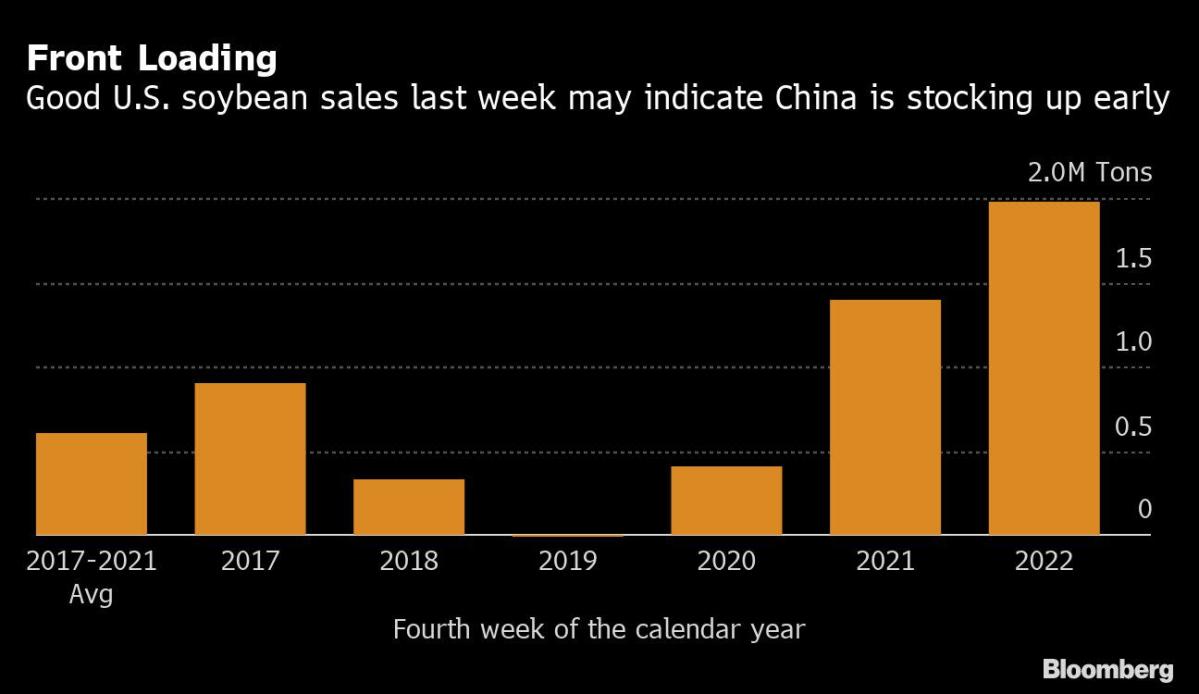
(Bloomberg) — Soybean buyers stung by puny yields and harvest delays in Brazil are turning to the U.S. for supply, driving up prices and threatening to worsen food inflation.
What was expected to be a record crop in Brazil is now looking far smaller as adverse weather events catch traders and end-users shorthanded. More than 110 ships have been chartered to load crops at ports in the Pacific Northwest, according to Bill Tierney, chief economist for AgResource Co. in Chicago.
The rush by physical traders and financial players has boosted benchmark Chicago futures by 31% since early November to an eight-month high, with the premium for July-versus-November contracts surging eightfold. Demand for immediate delivery has pushed cash prices at elevators in places like Iowa and Illinois to unusually high premiums over futures.
Money managers have raised bullish bets on soybeans to the highest in more than eight months, the latest weekly U.S. Commodity Futures Trading Commission data showed Friday.
The impact of higher soy costs is set to ripple through food supply chains at a time when global prices already are near a record. It will be more expensive to feed pigs, chickens and other livestock with meal crushed from beans, while the price of the other primary soy byproduct — cooking oil — also may climb.
“South America’s soybean losses put a great responsibility on the U.S., where plantings and yields will need to increase to avoid” persistent high prices, Etore Baroni, an analyst at StoneX in Brazil, said Thursday during a webinar.
U.S. soybean sales for export jumped to almost 2 million tons last week, exceeding all analyst forecasts. The U.S. Department of Agriculture on Friday reported an additional sale of 252,000 tons to “unknown” buyers.
Chinese firms and other buyers typically look to South America for supply at this time of year as farmers harvest their latest crop and truck them off to ports. As recently as a few months ago, all signs were for a bumper crop — some 145 million tons in Brazil, 50 million from Argentina and 10 million in Paraguay.
But then a La Nina weather system swept key growing regions in southern Brazil and Argentina with heat and drought, damaging crop. Moreover, more dry stretches probably still lie ahead, according to the weather forecaster Maxar.
Brazil, Argentina and Paraguay will export some 20 million tons less than projected, according to analysts. Strong processing margins will keep demand for soybeans elevated in Brazil, with local industries competing with foreign buyers, Baroni said.
The signs of urgent demand are clear in the rising levels of so-called basis differentials and physical prices in market hubs of Santos and New Orleans. Farmers in Brazil are being offered record prices, and ships are lining up outside the main export terminals as traders vie to secure any beans they can to fill vessels bound for China and other markets.
The basis, or premium buyers will pay above futures, is up 35% this year in Santos; in New Orleans, it’s $1.34 a bushel, up almost 60% from a year ago.
‘Game-Changer’
Brazil’s soybean exports could reach 9.9 million tons in February, according to the National Association of Cereal Exporters. While that’s a record for the month and almost double from last year, when the oilseed harvest was delayed by late planting, the monthly export capacity is around 16 million, which shows that supplies are slow getting to the ports.
“We are seeing a big concern for summer, as Brazil is 20 cents higher per bushel than U.S. Gulf in June and July,” said Arlan Suderman, chief commodities economist at StoneX. “That seems to be the market telling us that they are running out of supplies and we can see more demand coming to the U.S. If this is true, this is a dramatic game-changer.”
Chicago soybeans for March delivery posted a third straight week of gains on Friday, climbing to a fresh eight-month high of $15.535 a bushel. Wheat and corn also rose. Chinese markets reopen on Monday after the week-long Lunar New Year holiday.
©2022 Bloomberg L.P.